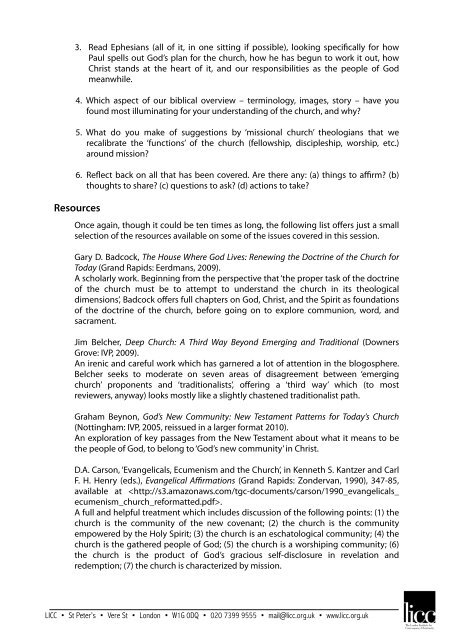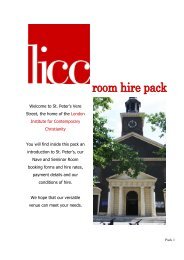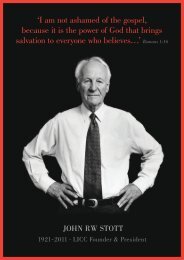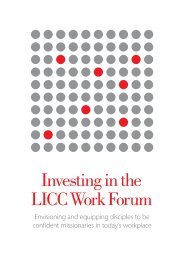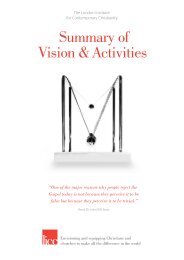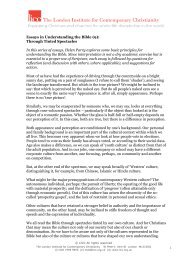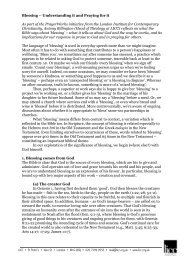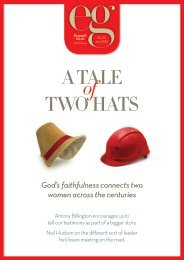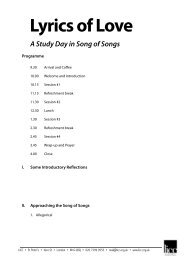03 GSD Handout - The London Institute for Contemporary Christianity
03 GSD Handout - The London Institute for Contemporary Christianity
03 GSD Handout - The London Institute for Contemporary Christianity
Create successful ePaper yourself
Turn your PDF publications into a flip-book with our unique Google optimized e-Paper software.
3. Read Ephesians (all of it, in one sitting if possible), looking specifically <strong>for</strong> howPaul spells out God’s plan <strong>for</strong> the church, how he has begun to work it out, howChrist stands at the heart of it, and our responsibilities as the people of Godmeanwhile.4. Which aspect of our biblical overview – terminology, images, story – have youfound most illuminating <strong>for</strong> your understanding of the church, and why?5. What do you make of suggestions by ‘missional church’ theologians that werecalibrate the ‘functions’ of the church (fellowship, discipleship, worship, etc.)around mission?6. Reflect back on all that has been covered. Are there any: (a) things to affirm? (b)thoughts to share? (c) questions to ask? (d) actions to take?ResourcesOnce again, though it could be ten times as long, the following list offers just a smallselection of the resources available on some of the issues covered in this session.Gary D. Badcock, <strong>The</strong> House Where God Lives: Renewing the Doctrine of the Church <strong>for</strong>Today (Grand Rapids: Eerdmans, 2009).A scholarly work. Beginning from the perspective that ‘the proper task of the doctrineof the church must be to attempt to understand the church in its theologicaldimensions’, Badcock offers full chapters on God, Christ, and the Spirit as foundationsof the doctrine of the church, be<strong>for</strong>e going on to explore communion, word, andsacrament.Jim Belcher, Deep Church: A Third Way Beyond Emerging and Traditional (DownersGrove: IVP, 2009).An irenic and careful work which has garnered a lot of attention in the blogosphere.Belcher seeks to moderate on seven areas of disagreement between ‘emergingchurch’ proponents and ‘traditionalists’, offering a ‘third way’ which (to mostreviewers, anyway) looks mostly like a slightly chastened traditionalist path.Graham Beynon, God’s New Community: New Testament Patterns <strong>for</strong> Today’s Church(Nottingham: IVP, 2005, reissued in a larger <strong>for</strong>mat 2010).An exploration of key passages from the New Testament about what it means to bethe people of God, to belong to ‘God’s new community’ in Christ.D.A. Carson, ‘Evangelicals, Ecumenism and the Church’, in Kenneth S. Kantzer and CarlF. H. Henry (eds.), Evangelical Affirmations (Grand Rapids: Zondervan, 1990), 347-85,available at .A full and helpful treatment which includes discussion of the following points: (1) thechurch is the community of the new covenant; (2) the church is the communityempowered by the Holy Spirit; (3) the church is an eschatological community; (4) thechurch is the gathered people of God; (5) the church is a worshiping community; (6)the church is the product of God’s gracious self-disclosure in revelation andredemption; (7) the church is characterized by mission.LICC • St Peter’s • Vere St • <strong>London</strong> • W1G 0DQ • 020 7399 9555 • mail@licc.org.uk • www.licc.org.uk


